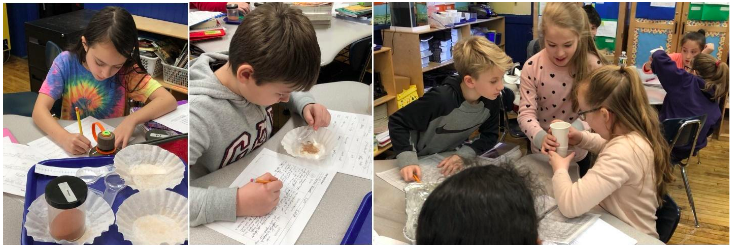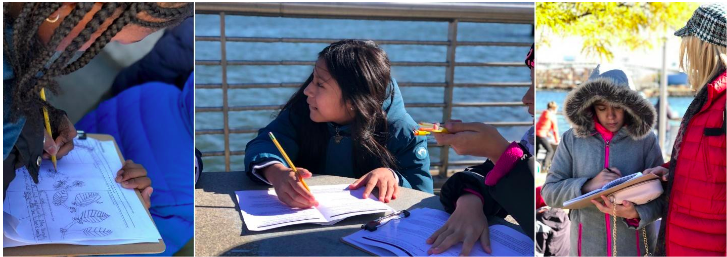By Tina Wong, Sustainability Coach at National Wildlife Federation’s Greenpoint Eco-Schools Program
“Ms. Marshall threw a bucket into the creek! When she pulled it back up, there was all this seaweed in it,” exclaimed Alicja Koziel, 5th Grader. On October 30, 2018, P.S. 34 took all three 5th Grade classes on a field trip to NYC Environmental Protection’s Newtown Creek Nature Walk so that they could get an intimate look at our local waterway. Sixty-five students traveled along the quarter mile path, which was designed to evoke the rich, continually evolving environmental, industrial and cultural histories surrounding Newtown Creek. At the top of the Turret and before the Seven Stone Circles, I demonstrated how water flows in our built environment. Ms. Marshall (Green STEM Cluster teacher) conducted water quality tests at the Watershed Bollard and Sarah Ward (Greenpoint Eco-Schools Program Manager) guided students on a native plant exploration on the Whale Creek Path.

For the last two months, 5th Grade teachers at P.S. 34 have taught a new curriculum from Newtown Creek Alliance (NCA) that focuses on our local, urban ecology. English Language Arts (ELA) teacher, Ms. Wildermuth taught the Flora and Fauna unit. “It aligns perfectly with my Expeditionary Learning curriculum on Biodiversity,” she said. Engaging her students in interactive activities like the “Invasive species” game, where they take on the roles of native and invasive species and compete for limited resources, promotes deeper understanding of balance and interdependence in an ecosystem, the concept of diminishing resources and competition among species. “They were so into it; it felt like the Hunger Games.” she said.
Alicja Koziel, 5th Grader, remembered the exercise. “We played a game with our teacher Ms. Wildermuth. She put these circles that represented shelter, water and food on the floor. We need to have one of each to survive and when she said so, we had to run to get it. All of us were native species at the beginning and would take one at time. After three rounds, Ms. Wildermuth added in invasive species. The invasive species were able to take as many resources as they wanted! So then the native species wasn’t able to get all three resources and would die off. She later added in more invasive species and they just took everything! I was a Goldenrod, a native species, and I felt like I didn’t matter. It was horrible. I felt bad for the Black Locust and the Black Cherry Tree which were native species like me.”

With Ms. Marshall, students in Green STEM class explored the Watershed and Sewershed unit. Ms. Marshall used Google Earth to “show” how water flows in our neighborhood, through our streets from our school, and to the Creek. Students built their own watershed models, learned about permeable versus impermeable surfaces, and discussed the impacts of pollution in our waterway as well as NYC’s Combined Sewer Overflow (CSO) system. Needless to say, the idea of poo in our Creek was upsetting to all. “We should not shower or do laundry when it rains because then the pipes get full and all the waste we flush down the toilets goes into Newtown Creek and will kill all the animals,” said Philip Liew, 5th Grader.

In Science class, Ms. Kubis took a deeper look at soil with her students, teaching the Soil Quality unit. In this unit, she talks about the diversity of life in soil and how it contributes to soil health. Students learned about the indicators of what healthy soil would look like and how to test it!

This is the first time that the school has integrated one subject (Newtown Creek’s Urban Ecology) into 3 disciplines (ELA, Green STEM, Science) at the same time! And to bring this all together, for their final Applied Learning unit which was redesigned to fit the way the NCA curriculum was taught at P.S. 34, all students will engage in a “Community Impact Project” and will spend the next five week in Green STEM class designing an improvement that will positively impact the Creek. Groups will choose one of four topics (Plant Restoration, Stormwater Management, Soil or Water Quality Improvement), use the Design Thinking Process, (empathize, define, ideate, prototype, and test,) and draft proposals to make recommendations for improvements. I can’t wait to see the student solutions to these real-world problems.

Community Impact Project is a follow up to the School Impact Projects unit from P.S. 34’s Green STEM curriculum and uses the Place-Based Education methodology where we educate for sustainability grounded in place. “When children know and have a deep connection to their place, they are more likely to care for and contribute to making that place a better place for all to live in.” -Shelburne Farms.


